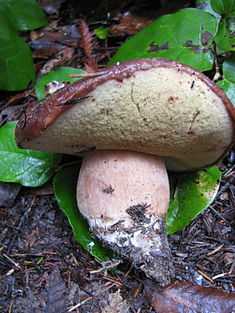Boletus regineus
| Boletus regineus | |
|---|---|
 | |
| From Little River (Mendocino County), California | |
| Scientific classification | |
| Kingdom: | Fungi |
| Division: | Basidiomycota |
| Class: | Agaricomycetes |
| Order: | Boletales |
| Family: | Boletaceae |
| Genus: | Boletus |
| Species: | B. regineus |
| Binomial name | |
| Boletus regineus Arora & Simonini | |
| Boletus regineus | |
|---|---|
|
| |
| pores on hymenium | |
| cap is convex | |
| hymenium is adnate | |
| stipe is bare | |
| spore print is olive | |
| ecology is mycorrhizal | |
| edibility: choice | |
Boletus regineus, commonly known as the queen bolete,[1] is an edible and highly regarded fungus of the Boletus family that inhabits southwestern North America. It was considered a variant of the similarly edible B. edulis for many years until declared a unique species in 2008.[2] Phylogenetic analysis has shown B. regineus as a member of a clade, or closely related group, with B. subcaerulescens, Gastroboletus subalpinus, B. pinophilus, B. fibrillosus, and B. rex-veris.[3]
See also
References
- ↑ Wood M, Stevens F. "California Fungi: Boletus regineus". MykoWeb. Retrieved 2009-11-02.
- ↑ Arora D. (2008). "California porcini: three new taxa, observations on their harvest, and the tragedy of no commons". Economic Botany 62 (3): 356–75. doi:10.1007/s12231-008-9050-7.
- ↑ Dentinger, Bryn T.M. et. al (2010). "Molecular phylogenetics of porcini mushrooms (Boletus section Boletus)". Molecular Phylogenetics and Evolution 57: 1276–1292. doi:10.1016/j.ympev.2010.10.004. PMID 20970511.